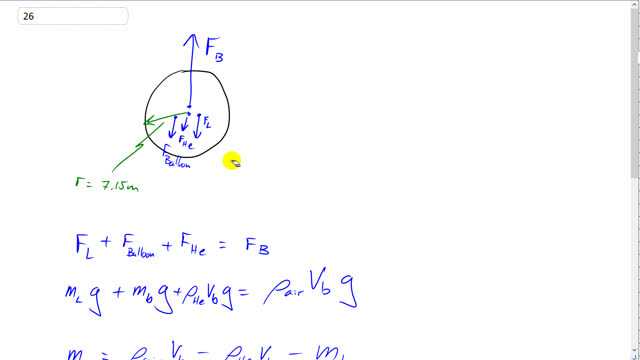
A spherical balloon has a radius of 7.15 m and is filled with helium. How large a cargo can it lift, assuming that the skin and structure of the balloon have a mass of 930 kg? Neglect the buoyant force on the cargo volume itself

In order to watch this solution you need to have a subscription.
This is Giancoli Answers with Mr. Dychko. There's going to be one upwards buoyant force on this balloon and then there's gonna be three forces down: one due to the load that it is carrying— that's what we have to calculate, what mass can that load have; and then also the force down due to the weight of the helium; and then there's also the weight of the balloon downwards. So all these down forces have to add up to equal the buoyant force at this point where the load force is at its maximum. So we have mass of the load times g plus mass of the balloon times g for the weight of the balloon plus the mass of the helium which is the helium's density times its volume—volume of the balloon—and that times g equals the density of air times the volume of the balloon that gives us the mass of the air and times g and the g's cancel everywhere and we have mass of the load is gonna be density of air times volume of the balloon minus each of these terms so we take each of those to the right hand side of the equation by subtracting it from both sides and we have density of air times volume of the balloon minus density of helium times volume of the balloon minus mass of the balloon. And we can factor out the balloon volume from both of these terms and balloon volume such as a sphere is four-third's times π times the radius cubed times density air minus density helium minus mass of the balloon and that gives us four-third's π times 7.15 meters cubed times 1.29 kilograms per cubic meter— density of air— minus 0.179 kilograms per cubic meter— density of helium— minus 930 kilograms of the balloon which gives 770 kilograms is the maximum mass that can be lifted by this helium balloon.